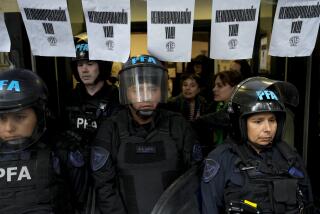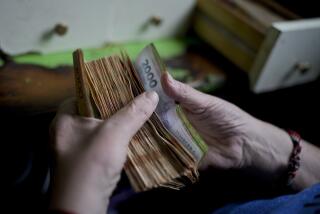Argentine Currency Proposal Criticized
- Share via
MEXICO CITY — Economists and Wall Street analysts criticized Argentina’s plan to introduce a new currency, warning that instead of fixing a moribund economy, it might lead to a new round of hyperinflation, bigger government deficits and continued civil unrest.
President Adolfo Rodriguez Saa, the Peronist governor of San Luis province, said when he took office Sunday that a new currency will circulate along with the peso. He promised not to abandon the peso’s peg to the dollar, nor to “dollarize” the economy by replacing pesos with dollars. He also said Argentina will halt payments on its crushing $132-billion foreign debt for now, in effect going into default.
The new money is designed to bring liquidity to a financial system that has seen funds dry up as a result of recession, deflation and massive bank withdrawals caused by savers who, seeing the peso weaken, moved their money into dollars.
But economists Monday saw the new currency, dubbed argentinos in the local press, as an expedient that might exacerbate the nation’s problems. The new currency amounts to a license to print money to pay Argentina’s bills, a prescription for hyperinflation, they said.
“The Peronists were unwilling to accept the political costs of an out-and-out devaluation, nor were they willing to abide by monetary discipline,” said Michael Gavin, a Latin America economist at UBS Warburg in Stamford, Conn. “This is not a stable monetary regime. You could get an old-style Argentina inflation,” he said in a reference to the late 1980s, when inflation exceeded 3,000% annually.
The move generally saddened economists, who fear that the reappearance of high inflation in the weeks and months ahead could spark more civil unrest, which has left 29 dead this month. Many expressed disappointment that Rodriguez offered no plan to attack the root of Argentina’s problem: the government’s propensity to spend more than it takes in in taxes.
“They clearly have made things worse. This is a move by a temporary administration trying to position themselves to buy an election,” said Steve Hanke, professor of applied economics at Johns Hopkins University, who also fears hyperinflation.
Wall Street analysts remain unconvinced about the staying power of the new currency. Walter Molano, an economist with BCP Securities in Greenwich, Conn., is among those said the Argentines “will be forced to devalue at some point in time.” Hanke said Argentina inevitably will have to dollarize the economy.
“It’s easier to say probably where we will be in six months than the next three weeks’ time,” said one currency expert who asked not to be identified. “You can argue that in six months we will see a sharply devalued Argentine currency, by 50% or more, and the economy as a whole taking a hit. How we get there is the uncertainty.”
Rodriguez, who will serve as caretaker until a presidential election is held in March, took office after widespread rioting and labor strikes forced the resignation of Fernando de la Rua, whose efforts over two years in office to fix Argentina’s broken economy fell flat.
The problem economists see with the new currency is its value. Just how much will the free-floating currency be worth in Argentina’s economy and outside it is yet to be seen, but economists expect its value to be half or less than half that of the dollar-pegged peso.
“Will shop owners, banks, cable-TV companies and restaurants even accept it? And if so, at how much discount? If the government workers find that it’s not accepted at all or at a steeply devalued rate, there could be worse civil unrest than we’ve seen,” the currency expert said.
If Argentina slowly replaces the peso with the new devalued currency, many businesses and consumers would find it impossible to meet their obligations, which are overwhelmingly dollar-denominated. That could lead to a round of bankruptcies and layoffs in an economy that already features 18% unemployment and an additional 14% of the work force underemployed.
Details of the new currency are sketchy, but reports say the government may print $10 billion worth and introduce the money as payment to government employees. That would about equal the $10 billion in pesos in circulation, a level that has shrunk as skittish Argentines have converted to dollars.
The new money will expand and legitimize the use of scrip or vouchers that federal and local governments have issued in recent months to pay civil servants. Thus the federal government, Hanke said, effectively will take on responsibility for the profligate spending of the provinces, a prime cause of Argentina’s dire situation.
Analysts searched for precedents for Argentina’s plan. Other countries--mainly unstable and impoverished nations such as Botswana, Afghanistan and Russia--have used multiple currencies.
The parallel currencies generally are designed for different kinds of transactions, one for exports and the other for imports. But the Argentine plan sets up a system by which the new currency will compete with the dollar-pegged peso, apparently in domestic and foreign markets. The new currency is bound to lose much of its value in such a face-off.
Multi-currency regimes have disappeared over the last decade, as they have been frowned upon by the International Monetary Fund.
“In general, markets don’t like tinkering, and that’s been the problem with Argentina all along,” said Brian Gendreau, an equity strategist with Salomon Smith Barney in New York.
More to Read
Sign up for Essential California
The most important California stories and recommendations in your inbox every morning.
You may occasionally receive promotional content from the Los Angeles Times.










